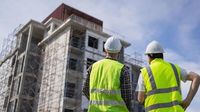England’s ambitious housebuilding targets have hit a formidable roadblock, as newly released official data reveals planning approvals for new homes have fallen to their lowest level in over a decade. This decline, which comes during Labour’s first year in office, has cast serious doubt on the government’s pledge to deliver 1.5 million new homes by the next general election—a promise that would require construction of roughly 300,000 homes each year.
According to figures published by local authorities and corroborated by BBC Verify, fewer than 29,000 housing projects were granted planning consent in the year to June 2025. This represents a record low and a striking blow to the government’s flagship housing policy. The data is even more concerning when broken down: just 7,000 applications were approved between April and June 2025, the lowest three-month figure since records began in 1979 and an 8% decline from the same period last year.
Steve Reed, who recently succeeded Angela Rayner as housing secretary, did not mince words about the situation. “These figures are unacceptable. I will leave no stone unturned to build 1.5 million homes, so families have the key to home ownership in their hands,” Reed said, as quoted by BBC. His plans to address the crisis include an overhaul of the Building Safety Regulator’s performance and working closely with London Mayor Sadiq Khan to unlock housebuilding in the capital.
But Reed also cautioned that reforming the planning system “won’t happen overnight.” The complexity of the problem is underscored by data from housing contractor Glenigan, which suggests that 221,000 individual homes were granted permission in the year to June 2025—a drop from 237,000 the year before. This downward trend in approvals is being felt across the board, with both the number of applications received and the number of decisions made by councils in decline.
Despite the gloom, there’s a small silver lining: councils are approving a greater proportion of the applications they handle. About 75% of applications decided were approved in the year to June 2025, up from 71% the previous year. Yet, as Neil Leitch, managing director of development finance at Hampshire Trust Bank, told Property Industry Eye, “The planning system remains a major hurdle. Recent data from the Home Builders Federation showed approvals are at their lowest level in 13 years, which makes the Government’s pledge to deliver a million homes this Parliament look increasingly unrealistic. Developers want to build, and lenders are ready to support them, but the delivery chain is simply not strong enough to turn ambition into delivery.”
Leitch went on to stress the importance of the upcoming Budget as an opportunity to give housebuilding a real boost, not only by providing planning departments with greater resources but also by attracting more skilled people into planning roles. “Without that investment, the system will remain too slow and inconsistent to support the homes we need. We also need to be clear that today’s approvals are not tomorrow’s completions. Too many schemes stall between consent and delivery, and if that pipeline continues to thin out, the shortfall in housing output will only grow.”
On the political front, criticism has come swiftly from the opposition. Conservative shadow housing secretary Sir James Cleverly argued, “Labour had promised to ‘build, build, build’ but their flagship planning reforms clearly aren’t working.” The sentiment is echoed by housing market analyst Neal Hudson of BuiltPlace, who told BBC, “Labour hit the ground running with their housing policies last year but the issue is they were trying to fix the wrong problem. Housebuilders and developers will not plan for and build homes if there’s no one to buy them. Unfortunately, that’s the case given current house price levels and mortgage rates, while the government’s affordable homes programme is underwhelming given the aspirations for 1.5 million.”
The government, for its part, has announced a £39 billion investment over 10 years to build hundreds of thousands of new social and affordable homes. Housing targets for local councils were also set last December in a bid to spur progress. However, as government figures show, the number of new homes receiving their first energy performance certificate (EPC)—a leading indicator of new builds—also fell during Labour’s first year in office. Ministers have attributed some of the slowdown to legacy issues from the previous Conservative government.
While the number of new home applications has reportedly risen sharply, according to Planning Portal, the approvals may be delayed due to significant backlogs. Geoff Keal from Planning Portal explained, “Getting to the decision stage can take several months. Backlogs mean approvals for this wave of applications may not appear until later in the year.”
Industry experts are not convinced that the current trajectory will change without significant intervention. Hannah Aldridge, senior research and policy analyst at the Resolution Foundation, remarked, “Planning approvals in the second quarter of 2025 were at their lowest level since records began. While a single planning application can cover multiple units of housing, separate data suggests that the number of individual dwellings being approved has also fallen. These figures are an advanced indicator of future housing supply, and the drop in approvals casts doubt on the Government’s ability to meet its target of 1.5m additional homes by the end of the Parliament.”
Fergus Charlton, planning partner with national law firm Michelmores, suggested that while there are plenty of delays embedded in the planning system, focusing on demand-side matters could help. He noted that removing certain bureaucratic hurdles—like streamlining section 106 negotiations or revising pre-commencement conditions—could speed up delivery on the supply side.
Meanwhile, Nathan Emerson, chief executive of Propertymark, welcomed the new housing secretary’s efforts to expedite home delivery, highlighting the Planning and Infrastructure Bill as a step in the right direction. “It’s positive to see that there has been an emphasis from the new Housing Secretary to put plans in place to speed up the delivery of homes across England. Legislative efforts are being moved forward, such as the Planning and Infrastructure Bill, which is heading towards Report Stage, and looks to streamline the planning process and make it simpler to build new homes. However, as it currently stands, there is some way to go to not only meet the UK Government’s ambitious housebuilding targets but also reach the continuing demand for appropriate properties in suitable locations.”
Emerson also pointed out that escalating building costs and ongoing supply issues continue to dampen confidence in a quick turnaround. “With building costs escalating and ongoing issues concerning a lack of supply, there is little confidence that, given the current disparity in supply and demand, we are going to see a sudden upturn in the numbers without further intervention. The UK Government must prioritise its commitment to invest in homes of all tenures, as an increase in housing supply will help to stabilise house prices and rents.”
The government’s ambitious housebuilding agenda now faces a critical test. With planning approvals at a record low and industry voices calling for urgent reform and investment, the path to 1.5 million new homes looks increasingly steep. Whether Labour can turn the tide remains to be seen, but the stakes for families hoping to get on the housing ladder have rarely been higher.




